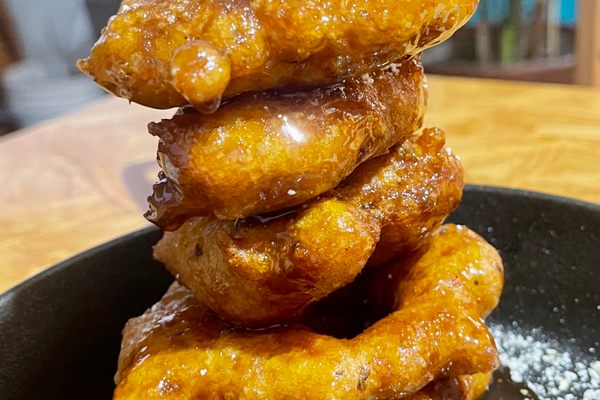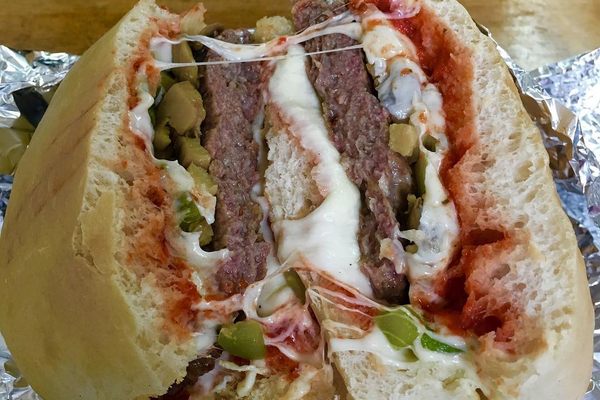As you stroll through the streets of Peru in search of a bite to eat, you might see a chef or street-side vendor pulling chunks of cooked meat from what looks like the top of an oil drum. This is the cilindro peruano, or Peruvian cylinder, a practical type of Peruvian roasting oven that has become increasingly popular in the last decade.
The precise origins of the cilindro peruano are not known for sure, but two similar tales are often told to account for its existence. The first tells of a group of Chinese laborers who came to Peru during a wave of immigration from 1849 to 1874. They were poor and had next to nothing in the way of cooking utensils. So when they found a sheet of tin, they rolled it into a cylinder and lit a fire inside. It protected the fire from the wind, and served as both an oven and a source of heat in the blustery coastal winter.
The alternative account is similar, but replaces the Chinese laborers with shipwrecked Peruvian fishermen. According to this story, the fishermen were stranded on an island off the Bay of Paracas in southern Peru. The nights were cold and their fires kept going out. They searched the beaches for any flotsam or jetsam that may have washed up, and came across a sheet of tin. The fishermen rolled it into a cylinder to protect the struggling fire. They then discovered that it served equally well as an oven.
Whether either story has any validity is anyone’s guess. It also doesn’t seem beyond the realm of possibility that an oil drum was used to make the first cilindro peruano, not a sheet of tin. Today’s cylinders look almost identical to oil drums, and some are made from oil drums. The standardized 42-gallon oil barrels we know today came into use in 1866, so it’s possible that Chinese workers or stranded Peruvian fishermen could have found one washed up on the coast of Peru in the late 1800s.
Either way, the design stuck. Today, the cilindro peruano is one of two transportable roasting ovens used in Peru, the other being the caja china (“China box,” known in Cuba as a caja asadora and in Louisiana as a Cajun microwave). Unlike the caja china, which in Peru is used almost exclusively for roasting pork and has the coals resting above the meat, the cilindro peruano has the coals at the bottom and is used for both pork and chicken, although other meats, including fish, duck, and cuy (guinea pig) can be placed inside.
The cylinder is normally divided into three sections. The bottom third is for the fire, accessible through a door in the side of the cylinder. The middle section often has a grill for placing side dishes, and sometimes a tray for collecting fat dripping from above. The upper section, meanwhile, has a metal cross, circle, or grid, from which hang a series of metal hooks. The meat is hung from these hooks to cook.
Meats cooked in a cilindro peruano take on a smoky flavor thanks to the way the smoke circulates throughout the cylinder. To give additional flavor to the smoke and, in turn, the meat, some chefs place a tray of water containing aromatic herbs into the cylinder’s mid-section.
Where to Try It
-
La Cochera Restaurante
Calle Ignacio Cossío 1337, Lima, PeruThis restaurant is famous for its meats cooked in Peruvian cylinders.
-
Caja Criolla Restobar
Jr. Rioja 328, Tarapoto, PeruThis Tarapoto establishment specializes in pork and chicken cooked in cilindro peruano and caja china.
Written By
 Tony Dunnell
Tony Dunnell
Sources
- peruvianfoodusa.com/es/cilindro-peruano-o-la-caja-china/
- cilindroperuano.blogspot.pe/2009/03/historia-del-cilindro.html
- peru21.pe/cultura/cocina-cilindro-imprenta-mecanica-fiesta-brasas-78807
- aoghs.org/transportation/history-of-the-42-gallon-oil-barrel/
- library.brown.edu/create/modernlatinamerica/chapters/chapter-6-the-andes/moments-in-andean-history/chinese-peru/

















